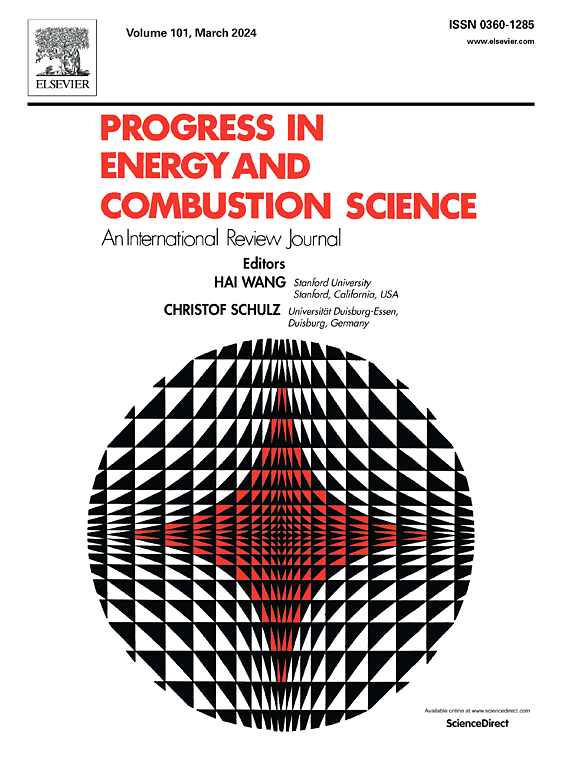末端气体自燃和密闭空间爆炸
IF 37
1区 工程技术
Q1 ENERGY & FUELS
引用次数: 0
摘要
末端气体自燃,特别是在密闭空间内爆轰发展,是一种复杂的物理现象,包括预混火焰动力学、流体动力学、自燃化学等,通常被认为是内燃机爆震和超爆震的根源。此外,爆轰起爆机理还与火灾安全和工业灾害有关。因此,本文从理论分析、光学诊断和高分辨率数值模拟等方面综述了近年来对密闭空间爆轰燃烧终末气体自燃现象机理的基本认识,重点讨论了终末气体自燃发生和传播两个阶段的关键物理化学因素的影响。首先,对Livengood-Wu (L-W)积分和反应性梯度理论这两个基本理论进行了论证,这两个理论分别为理解自燃发生和自燃传播提供了理论基础。特别阐述了L-W积分的应用和局限性,以及布拉德利图在更接近实际情况的多维条件下的推广。然后,全面研究了影响密闭空间内气体自燃和爆轰发展的几个关键物理化学因素,包括火焰传播、压力波、不均匀性、湍流、化学反应性和热力学条件。结果表明,燃气自燃过程包含火焰、压力波和自燃三个基本要素。火焰-压力相互作用诱导的末端气体自燃爆轰可分为反应性增强阶段、临界敏感阶段和耦合爆轰阶段三个阶段。前两个过程解释了自燃的发生,第三个过程解释了自燃的传播。对于自燃的发生,在弱压力波条件下,增加湍流火焰速度可以抑制末端气体自燃,而在强压力波条件下,增加湍流火焰速度可以促进末端气体自燃。在自燃传播方面,由温度、成分、添加剂引起的反应性梯度以及负温度系数(NTC)区域内的冷点可产生多种燃烧模式,而低温化学(LTC)和多级点火的存在使自燃传播更加复杂。结果进一步表明,小特征长度尺度的非均匀场和大特征长度尺度的非均匀场,加上小特征长度尺度的湍流和足够大的湍流速度波动,都能减弱爆轰倾向。此外,燃料类型、稀释气体和热力学条件对自燃的发生和传播都有影响。然而,燃料类型和能量密度对自燃传播的影响可能不能完全由布雷德利图解释,而应单独考虑。最后,讨论了内燃机末端气体自燃的随机性以及从爆燃到爆轰过渡(DDT)在管道内爆轰的异同,并从目前的基础研究中得到了工程应用和未来展望的启示。本文章由计算机程序翻译,如有差异,请以英文原文为准。
End-gas autoignition and detonation in confined space
End-gas autoignition, especially with detonation development in a confined space, is a complex physical phenomenon, including premixed flame dynamics, fluid dynamics, autoignition chemistry etc., which is generally considered as the origin of knock and super-knock in internal combustion (IC) engines. Furthermore, the mechanism for detonation initiation is also related to fire safety and industrial disasters. Thus, this review focuses on the recent progress made in the fundamental understanding of the mechanisms of end-gas autoignition phenomena along with detonation combustion in confined spaces through theoretical analyses, optical diagnostics, and high-resolution numerical simulations, with emphasis on the effects of crucial physicochemical factors on the two stages of end-gas autoignition, namely autoignition occurrence and autoignition propagation. Firstly, two basic theories, namely Livengood–Wu (L–W) integral and the reactivity gradient theory, which provide theoretical foundations for understanding autoignition occurrence and autoignition propagation, respectively, are demonstrated. Specially, applications and limitations of L-W integral and the extension of Bradley's diagram to multi-dimensional conditions closer to actual circumstances are elaborated. Then, a comprehensive investigation of several pivotal physicochemical factors involved in end-gas autoignition and detonation development in confined spaces, are conducted, including flame propagation, pressure wave, inhomogeneity, turbulence, chemical reactivity and thermodynamic conditions. The results indicate that, three essential elements are included in end-gas autoignition, namely flame, pressure wave, and autoignition. The flame-pressure interaction induced end-gas autoignition and detonation can be divided into three processes: I-reactivity increase, II-critical and sensitive state, and III-coupling and detonation. The first two processes account for autoignition occurrence and the third accounts for autoignition propagation. As to autoignition occurrence, increasing turbulence flame speed can inhibit end-gas autoignition under weak pressure wave conditions, whereas it can promote end-gas autoignition under strong pressure wave conditions. As to autoignition propagation, various combustion modes can originate from a reactivity gradient induced by temperature, composition, additive, as well as a cold spot within negative temperature coefficient (NTC) region, while the existence of low-temperature chemistry (LTC) and multi-stage ignition complicates autoignition propagation. The results further indicate that an inhomogeneous field with a small characteristic length scale, and an inhomogeneous field with a large characteristic length scale but coupled with the turbulence with a small characteristic length scale and a sufficiently large turbulent velocity fluctuation, can both weaken detonation propensity. Furthermore, the fuel type, diluent gas, and thermodynamic conditions can affect both autoignition occurrence and autoignition propagation. However, the effects of fuel type and energy density on autoignition propagation may not be completely explained by Bradley's diagram, and should be considered separately. Lastly, the review discusses the stochasticity of end-gas autoignition and the similarity and difference of detonation in IC engines from deflagration to detonation transition (DDT) in ducts, and provides inspirations obtained from the present fundamental studies for the engineering applications and future prospects.
求助全文
通过发布文献求助,成功后即可免费获取论文全文。
去求助
来源期刊

Progress in Energy and Combustion Science
工程技术-工程:化工
CiteScore
59.30
自引率
0.70%
发文量
44
审稿时长
3 months
期刊介绍:
Progress in Energy and Combustion Science (PECS) publishes review articles covering all aspects of energy and combustion science. These articles offer a comprehensive, in-depth overview, evaluation, and discussion of specific topics. Given the importance of climate change and energy conservation, efficient combustion of fossil fuels and the development of sustainable energy systems are emphasized. Environmental protection requires limiting pollutants, including greenhouse gases, emitted from combustion and other energy-intensive systems. Additionally, combustion plays a vital role in process technology and materials science.
PECS features articles authored by internationally recognized experts in combustion, flames, fuel science and technology, and sustainable energy solutions. Each volume includes specially commissioned review articles providing orderly and concise surveys and scientific discussions on various aspects of combustion and energy. While not overly lengthy, these articles allow authors to thoroughly and comprehensively explore their subjects. They serve as valuable resources for researchers seeking knowledge beyond their own fields and for students and engineers in government and industrial research seeking comprehensive reviews and practical solutions.
 求助内容:
求助内容: 应助结果提醒方式:
应助结果提醒方式:


